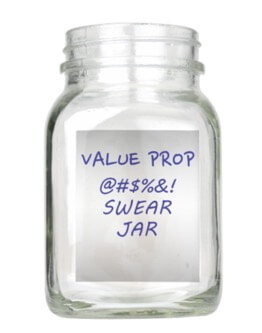Seven Sets of Words You Can Never Say in Value Propositions
- B2B buyers are tired of seeing value propositions bloated with meaningless buzzwords
- Ban these seven sets of overused and irrelevant words that commonly appear in value props
- Focus on words and phrases that distinguish you from the competition rather than making you blend in
Comedian George Carlin performed a famous routine “Seven Words You Can Never Say on Television,” in which he reflected on the seven words that were considered offensive (if you’re wondering what they were, Google them) and couldn’t be spoken over the public airwaves in the United States. Of course, this was before the days of cable television and streaming TV shows, which have different rules.
While most of the words and phrases we have seen in B2B value propositions are not considered dirty, they do offend for other reasons – namely, they are vague filler words that have no meaning to your buyers. They don’t do anything to satisfy the requirements of the five building blocks of best-in-class B2B value propositions (audience, need, assertion, outcome, distinction). In fact, they fail to distinguish your organization and offerings from the competition. Instead, they blend in with all the other “blah-blah-blah” messaging out there.
 Here are the seven sets of words and phrases that we would like – or are begging – portfolio marketers to stop using in value propositions – and recommendations on what to use instead:
Here are the seven sets of words and phrases that we would like – or are begging – portfolio marketers to stop using in value propositions – and recommendations on what to use instead:
- “Increase revenue, reduce cost, innovative.” Ah, the triad of corporate goals. If we mention these three phrases, we’re good, right? No, because they are too vague and miss the mark completely when defining buyer needs. Instead, focus on a buyer need that is specific to the buyer and includes the business value and the desired outcome (e.g. hire the best talent to give the company a competitive edge).
- “Breadth and depth, comprehensive, high performance.” Everyone has breadth and depth and is comprehensive and high performing in some respect, or so they claim. These words don’t set you apart – they assimilate you. Instead, focus on how your offering addresses the buyer need (e.g. gives mobile workers the data they need to make decisions on the go).
- “Single platform, end-to-end, integrated.” These phrases stopped being differentiators more than a decade ago. Buyers are tired of hearing them because most B2B organizations claim them regardless of whether they’re true. It’s best to forgo these terms completely. Instead, state how your offering addresses the buyer’s specific need using the buyer’s language – not vendor jargon (e.g. find, engage and hire passive and high-quality active candidates).
- “Efficient and effective.” Everyone claims to be efficient and effective, but when it comes time to prove it, there’s not much to talk about. If you have a claim related to efficiency, state the specific claim as a quantitative or qualitative outcome (e.g. reduced the sales cycle by two months) to set yourself apart.
- “Leader, leading, recognized as.” The words “leader” and “leading” are so overused and context barren that buyers don’t ever believe them. And the phrase “recognized as” usually goes something like this, “recognized as the leading provider…” It doesn’t say who is doing the recognizing, and the who may not matter to the buyer. Instead, state a distinction that your competitors can’t claim (e.g. world’s largest professional network, used by 90 percent of the Fortune 100) and be prepared to back it up.
- “Superior.” Superior to what or whom? It’s a superlative that comes across as arrogant and can’t be proven. Refer to the recommendations above to state your distinctive position (without using the word “leading”) that reflects a unique attribute of the company or offering.
- “Only Acme can.” Just throwing this phrase at the front of a sentence in a value proposition doesn’t satisfy the distinction requirement. Using this phrase actually works against B2B organizations – ban it now. We have even seen some organizations overuse this phrase so much (in an unbelievable way) that it has had a negative impact on their brand. Instead, focus on articulating what sets you apart from the competition (again, without using the word leading).
It’s probably clear by now that a thesaurus won’t solve the value proposition issues outlined above. Ridding your value propositions of these words and phrases requires having a deep understanding of your buyers and the ability to apply critical thinking and creativity. If you do find that your value propositions sound anything like “Provider XYZ, the leader in end-to-end, single-platform solutions, uniquely provides an integrated, best-in-class solution with the breadth and depth to solve your challenges reliably, efficiently and profitably,” please get help now. Contact us and setting up an inquiry with a portfolio marketing analyst. Our editing pens are waiting to help you create audience-centric value propositions that are distinctive and make an emotional connection with your target buyers.
To self-monitor and enforce the ban, consider using the equivalent of a “swear jar.” Each time a marketer uses one of these words or phrases, they have to put money in the jar, which will go to a nice team dinner, charity or other worthy cause. You might also check out the SiriusDecisions Messaging Nautilus™: Buyer’s Journey, which outlines an audience-centric messaging methodology including how to build best-in-class B2B value propositions.